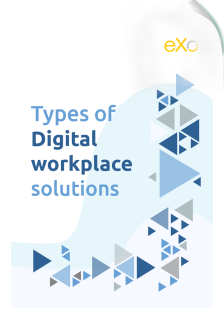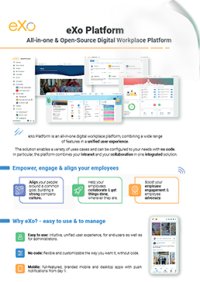


FREE WHITE PAPER
Digital workplace is a buzzword these days. Actually different people use it to mean different things. So what is a digital workplace?
The nature of work has undergone a seismic shift. The days of a physical office being the sole center of productivity are fading, replaced by a complex tapestry of hybrid models, remote teams, and digital-first processes.

The Digital Workplace Experience (DWX) is the day-to-day, end-to-end experience employees have when they interact with the digital tools, systems and services that let them do their jobs: intranets, collaboration apps, knowledge search, HR services, single-sign-on portals, micro-apps, notifications, learning hubs, analytics and any AI assistants that sit in the flow of work. In short, DWX = how people feel and perform when they work with your digital environment. RobinTanium
This article delves deep into the concept of Digital Workplace Experience (DWX), exploring its definition, importance, benefits, and how to implement a strategy to improve it, with a specific look at how platforms like eXo Platform are leading the charge.
The Digital Workplace Experience (DWX) is the holistic sum of how people in an organization engage with its digital tools, platforms, and services throughout their journey—from onboarding, through learning, through day-to-day work, through collaboration, up to career growth. It’s not merely about having technology; it’s about how that technology is designed, how the systems connect, how people feel, how easy it is to get work done, and how the organization supports employees in that flow.
A strong Digital Workplace Experience (DWX) is:
Digital Workplace Experience (DWX) is the sum of all interactions an employee has with the digital tools, applications, and environments provided by their employer. It transcends the mere existence of technology; it’s about how seamless, intuitive, engaging, and productive that technology makes the employee’s daily work life.
Think of it as the digital equivalent of a well-designed physical office. A great physical office has good lighting, comfortable chairs, easy-to-use meeting rooms, and a logical layout that fosters collaboration. A great Digital Workplace Experience (DWX) provides the digital equivalent: easy access to information, seamless communication tools, intuitive workflows, and a sense of community and belonging, all accessible from anywhere.
The very nature of work has undergone a seismic shift. The traditional office as the sole hub of productivity is fading fast, replaced by a hybrid tapestry of remote teams, flexible schedules, and digital-first processes. Work is no longer defined by a physical location—it’s defined by the quality of the digital environment employees use every day.
According to a 2024 Deloitte study, 83% of organizations now operate in some form of hybrid model, while 70% of employees cite digital friction—poorly designed systems, too many logins, or disjointed tools—as one of the top barriers to productivity (Deloitte, 2024).
When workplace tools fall short—fragmented, slow, or unintuitive—the consequences are real:
Employees want digital workplaces that don’t get in the way of their work but actively support and enhance it. Key expectations include:
When organizations invest in creating a seamless, supportive, and human-centric digital workplace experience, they unlock measurable advantages:
This is why Digital Workplace Experience (DWX) has become a strategic pillar of the modern workplace. It’s no longer a “nice-to-have” or just an IT project—it’s a business-critical capability that directly impacts competitiveness.
Organizations that get it right don’t just deliver smoother workflows; they create environments where people thrive, innovation flourishes, and resilience is built into the DNA of work.

Types of Digital workplace solutions
Digital workplace is a buzzword these days. Actually different people use it to mean different things. So what is a digital workplace?



Digital workplace is a buzzword these days. Actually different people use it to mean different things. So what is a digital workplace?
In today’s digital-first economy, organizations are no longer competing solely on products or services. Increasingly, they’re competing on the quality of the employee digital experience. According to Gartner, by 2027 organizations that prioritize digital employee experience will outperform their peers in talent retention rates by 25% (Gartner, 2024).
This shift explains why Digital Workplace Experience (DWX) has become a strategic priority for executives. It’s not just an IT upgrade or an HR initiative anymore—it directly impacts productivity, engagement, innovation, customer satisfaction, and ultimately, profitability.
Here are the key benefits of investing in a superior Digital Workplace Experience, supported by research and real-world insights.
Employees who feel supported by intuitive, connected, and human-centric tools are more motivated, committed, and less likely to leave.
A superior Digital Workplace Experience (DWX) reduces digital friction, creates a sense of belonging, and becomes a competitive differentiator in talent attraction and retention.
Employees waste an enormous amount of time navigating fragmented systems. McKinsey research found that employees spend 20–30% of their workweek just searching for information or trying to access the right tools (McKinsey, 2023).
A unified Digital Workplace Experience streamlines access to resources, integrates systems, and leverages AI for smarter workflows. This means:
The result is a measurable boost in organizational efficiency and output.
Onboarding is one of the first impressions a new employee has of an organization. A disjointed experience can delay integration and reduce confidence.
With a strong Digital Workplace Experience (DWX), new hires can:
This reduces time-to-proficiency and accelerates contribution to team goals—an especially critical factor in industries with high turnover.
Knowledge is one of the most valuable assets a company has, yet it’s often siloed in disconnected tools or lost when employees leave.
A robust Digital Workplace Experience (DWX) ensures that:
This not only prevents costly knowledge loss but also creates a culture of continuous learning.
Informed decisions require context. A connected Digital Workplace Experience improves visibility by:
This fosters a data-driven culture, where employees at all levels can act with confidence and agility.
In a fast-changing world, agility is survival. A superior Digital Workplace Experience (DWX) allows organizations to adapt quickly to new market realities, customer demands, or internal challenges.
For example:
By breaking down silos and encouraging cross-functional collaboration, Digital Workplace Experience (DWX) becomes a catalyst for creativity and innovation.
Culture can easily dissipate in dispersed or hybrid workplaces. A strong Digital Workplace Experience preserves and amplifies culture by:
At the same time, Digital Workplace Experience (DWX) supports employee well-being by reducing digital fatigue, setting boundaries, and offering wellness resources. A Future Forum survey reported that 43% of employees experience burnout linked to digital overload (Future Forum, 2024). A human-centered Digital Workplace Experience (DWX) helps combat this by designing tools and policies with well-being in mind.
Organizations that excel at Digital Workplace Experience (DWX) don’t just create happier employees—they create stronger businesses. By reducing friction, supporting engagement, and enabling innovation, they build a sustainable competitive advantage.
Ultimately, Digital Workplace Experience impacts:
This is why Digital Workplace Experience (DWX) has risen to the executive agenda: it’s a business imperative with measurable returns, not just a “nice-to-have.”
| Benefit Area | Employee Outcomes | Business Outcomes |
|---|---|---|
| Engagement & Retention | Employees feel supported, connected, and valued; reduced frustration and burnout. | Higher retention rates, stronger employer brand, lower recruitment costs. |
| Productivity & Efficiency | Faster access to tools and information; less time wasted on searching or navigating systems. | Significant time savings across the workforce, improved operational efficiency, direct cost savings. |
| Onboarding & Learning | New hires quickly access resources, understand culture, and build connections. | Reduced time-to-proficiency, faster integration of talent, quicker ROI on recruitment. |
| Knowledge Sharing & Retention | Easier discovery of information and expertise; collaborative learning culture. | Institutional knowledge preserved, fewer silos, better organizational intelligence. |
| Decision-Making | Employees and managers have transparent access to accurate data. | Smarter, faster, data-driven decisions; improved agility in responding to change. |
| Innovation & Agility | Opportunities for cross-functional collaboration and creativity. | Accelerated innovation, ability to pivot quickly in crises or new market demands. |
| Culture & Well-being | Stronger sense of belonging, recognition, and digital well-being. | A more resilient, values-driven culture that sustains performance long term. |
The terms Digital Workplace Experience (DWX) and Workforce Management (WFM) are often used interchangeably, but they serve very different purposes. Both are essential to a well-functioning organization, yet their focus, goals, and success metrics diverge sharply. Understanding this distinction is crucial for leaders who want to balance operational efficiency with employee empowerment.
Digital Workplace Experience (DWX) is all about the employee journey with workplace technology. It focuses on how individuals access information, collaborate with colleagues, and complete tasks across digital systems.
Put simply, Digital Workplace Experience (DWX) is about how people experience work every day. Research backs its importance: a 2024 Gartner report found that organizations investing in digital employee experience see a 20% improvement in engagement scores and are 2.2x more likely to retain top talent (Gartner, 2024).
WFM, by contrast, is more operational and management-centric. It ensures the right people, with the right skills, are in the right place at the right time.
This approach is especially critical in industries like retail, manufacturing, logistics, and call centers, where workforce planning directly affects service delivery and cost management.
Although DWX and WFM overlap, their value propositions differ. WFM solves “who works when”, while DWX solves “how well people can do their work and feel at work.”
| Feature | Digital Workplace Experience (DWX) | Workforce Management (WFM) |
| Primary Focus | Employee-centric: enhancing experience, satisfaction, and productivity. | Manager-centric: optimizing operational efficiency and compliance. |
| Goal | Enablement, engagement, retention. | Operational control, cost management, productivity tracking. |
| Key Metrics | eSat, eNPS, adoption rates, collaboration frequency, time-to-task. | Labor cost, schedule adherence, absenteeism, forecast accuracy. |
| Tools | Intranet, collaboration hubs, knowledge bases, AI assistants, social platforms. | Scheduling, time & attendance, payroll, labor forecasting. |
| Analogy | The modern office environment: designed to make work intuitive, enjoyable, and productive. | The factory floor manager: ensuring the right coverage at the lowest cost. |
A successful organization needs both:
Importantly, they are not siloed. In fact, a great DWX can make WFM more effective. For example:
A 2025 report by Forrester highlights that organizations integrating DWX and WFM platforms see a 27% improvement in productivity and a 19% increase in employee retention, proving that experience and efficiency go hand in hand (Forrester, 2025).
🤏In short:
While the terms digital employee experience (DEX) and digital workplace experience (DWX) are often used interchangeably, they emphasize different perspectives.
| Feature / Aspect | Digital Employee Experience (DEX) | Digital Workplace Experience (DWX) |
|---|---|---|
| Primary Focus | Employee satisfaction, engagement, and well-being | Operational efficiency, integration, and system performance |
| Goal | Enable employees to thrive in their work environment | Provide a seamless and functional digital ecosystem |
| Metrics | eNPS, employee satisfaction surveys, task completion efficiency | Adoption rates, workflow efficiency, uptime, integration success |
| Perspective | Human-centered | Tool/organization-centered |
| Tools & Platforms | Collaboration hubs, AI assistants, learning and well-being apps | Intranets, workflow automation, ERP/CRM integrations |
| Outcome | Higher engagement, retention, productivity | Reduced friction, better tool adoption, smoother workflows |
| Key Insight | DEX is about how employees feel and perform | DWX is about how well the digital environment functions |

The Complete Guide to
Employee Engagement
Discover our in-depth analysis of the concept of employee engagement, its roots, and ways to improve it significantly



Discover our in-depth analysis of the concept of employee engagement, its roots, and ways to improve it significantly
Not all Digital Workplace Experience (DWX) platforms are created equal. Organizations have different needs depending on their size, culture, industry, and maturity, and the platforms available on the market reflect those differences. Over the past decade, DWX solutions have evolved from static intranets into dynamic, AI-powered digital hubs.
Broadly speaking, Digital Workplace Experience platforms can be grouped into several categories:
The digital bulletin board, reimagined.
These platforms evolved from the classic corporate intranet, designed to centralize news, announcements, HR policies, and corporate knowledge. They excel at providing top-down communication and structured content repositories.
👉 According to Gartner’s 2025 Digital Workplace Report, only 18% of employees rate intranet-centric platforms as engaging, highlighting their limits in hybrid, fast-moving environments (Gartner, 2025).
Chat-first, teamwork-focused solutions.
These platforms are built around real-time communication and project collaboration. They typically start as chat or video tools and expand into task management, file sharing, and workflow automation.
📊 A Deloitte 2024 survey found that 70% of employees feel overwhelmed by too many collaboration apps, underscoring the importance of integration over isolated tools (Deloitte, 2024).
Focusing on the employee journey.
These modular suites aim to bring together communications, learning, wellbeing, and recognition into a personalized employee hub. They bridge the gap between HR, IT, and internal comms.
The enterprise content powerhouse.
Originally designed for customer experiences, DXPs now power content personalization and multi-channel delivery within the employee context too. They enable customized digital journeys across devices and channels.
📈 Gartner notes that 70% of large enterprises now use some form of DXP to support both employee and customer experiences, signaling convergence in the market (Gartner DXP, 2024).
The flexible, self-hosted option.
For organizations with strict data sovereignty, security, or customization needs, open-source digital workplace platforms provide maximum control. These can be hosted on-premises or in private clouds.
The “front door” to the modern workplace.
The most advanced category, IXPs unify all digital touchpoints—from collaboration and intranet to HR services, CRM, ERP, and even AI assistants—into a single, personalized interface. They directly address app overload and fragmentation, offering employees a seamless way to access everything they need.
🌍 The market is clearly moving in this direction: Forrester (2025) reports that organizations adopting IXPs see a 35% reduction in app-switching time and a 22% boost in employee productivity, making them the fastest-growing segment of the DWX market (Forrester, 2025).
In practice, most modern workplaces don’t rely on just one type. Instead, they deploy a hybrid model that combines:
This hybrid, employee-first architecture is what sets leaders apart in the digital workplace race.
🤏In short:
| Type | Primary Focus | >Strengths | Limitations |
|---|---|---|---|
| Intranet-Centric Platforms | Centralized news, policies, documents | Strong document management, compliance, central info hub | Often static, less engaging, poor real-time collaboration |
| Collaboration-Centric Platforms | Real-time communication & teamwork | Fast messaging, project collaboration, cross-functional work | Risk of silos, notification overload, fragmented if not integrated |
| Employee Experience Platforms (EXP) | Employee journey, engagement, learning | Personalized feeds, L&D integration, recognition, well-being | Depends on third-party integrations, risk of overlap |
| Digital Experience Platforms (DXP) | Content personalization & delivery | Multi-channel publishing, strong analytics, personalization | Complex, expensive, less employee-culture centric |
| Open-Source / Customizable Platforms | Flexibility, control, data sovereignty | Extensible, customizable, secure, self-hosted | Requires more IT resources, less plug-and-play |
| Integrated Experience Platforms (IXP) | Unified “front door” to all apps & services | Central hub, workflow automation, AI-powered, reduces app overload | Implementation complexity, needs governance |
📌 Key Insight:
While each type has value, the trend is decisively moving toward Integrated Experience Platforms (IXPs), as they tackle the growing problem of app overload and deliver measurable gains in productivity and employee satisfaction (Forrester, 2025).
Choosing the right Digital Workplace Experience (DWX) platform is critical. A strong Digital Workplace Experience is not just a set of tools—it’s the foundation for employee productivity, engagement, and well-being. Modern workplaces demand platforms that integrate seamlessly into daily workflows, reduce friction, and support the diverse needs of hybrid teams.
Below are the essential features organizations should look for today, along with why they matter and recent research supporting their impact.
A modern Digital Workplace Experience platform should serve as a single access point for all digital work, including communication, collaboration, HR, learning, and operational tools. By reducing app hopping and context switching, employees can focus on meaningful work rather than navigating a maze of disconnected systems.
Employees expect relevant, tailored experiences. A good platform delivers personalized dashboards, news feeds, notifications, and content recommendations based on role, location, team, or work style.
A modern Digital Workplace Experience (DWX) must include a Google-like search that surfaces information across people, documents, conversations, and integrated apps. Knowledge graphs and contextual search make it easy to find the right information at the right time.
The platform must connect to existing business applications—like HR systems, CRM, ERP, and workflow tools—through pre-built connectors and flexible APIs. This ensures a seamless flow of information and reduces duplicate work.
With remote and hybrid work now standard, platforms must provide fully functional mobile access and support asynchronous collaboration. Employees should be able to communicate, access content, and complete tasks from any location.
Digital Workplace Experience platforms should foster informal learning, peer recognition, and community engagement through spaces, activity streams, reactions, @mentions, and team forums.
Platforms should enable co-editing, version control, wikis, and content lifecycle management to turn individual knowledge into an organizational asset.
Modern platforms leverage AI and automation to anticipate employee needs, summarize content, route requests intelligently, and automate routine processes.
Digital Workplace Experience (DWX) platforms should include dashboards to measure engagement, adoption, search behavior, and content effectiveness, enabling continuous improvement.
Finally, a modern platform must support robust security, governance, and compliance with industry regulations while being flexible enough to scale with the organization.
A human-centered Digital Workplace Experience incorporates features that protect digital well-being, support psychological safety, and foster inclusive, transparent culture.
| Feature Category | Description & Why It Matters | Key Capabilities / Examples |
|---|---|---|
| Unified, Integrated Digital Ecosystem | A single access point for communication, collaboration, HR, learning, and operational tools. Reduces app hopping and context switching. McKinsey (2023) reports employees spend up to 30% of their workweek switching between apps, which reduces productivity. | Federated navigation, centralized dashboards, single sign-on (SSO) |
| Personalization & Role-Based Experiences | Provides personalized dashboards, notifications, and content based on role, location, team, or work style. Forrester (2024) shows personalized experiences increase engagement and adoption by up to 25%. | Smart recommendations for documents, learning modules, tasks, and workflows |
| Advanced Search & Knowledge Discovery | Google-like search across people, documents, conversations, and apps. Knowledge graphs and contextual search save time. Deloitte (2024) found 70% of employees struggle to find information, blocking productivity. | Unified search bar, AI-driven content suggestions, metadata tagging, intelligent recommendations |
| Seamless Integrations & Open APIs | Connects with HR, CRM, ERP, and other tools via APIs and pre-built connectors. Reduces silos and duplicate work. | Low-code/no-code integrations, micro-apps embedded in workflows, real-time data sync |
| Mobile-First & Hybrid Work Support | Ensures access anywhere with responsive mobile apps. Gartner (2024) found mobile-enabled workplaces increase engagement by 18%. | Mobile apps, offline access, push notifications, collaboration tools |
| Social Collaboration & Community Features | Encourages recognition, informal learning, and connection. Gallup (2024) shows connected employees are 3.7x more likely to thrive. | Communities of practice, social feeds, recognition modules, interactive forums |
| Knowledge Management & Content Governance | Supports co-editing, version control, and knowledge sharing. Prevents redundancy and knowledge loss. | Wikis, structured repositories, approval workflows, retention policies |
| AI, Automation & Workflow Orchestration | AI anticipates needs, routes requests, and automates processes. Microsoft & McKinsey (2025) note AI boosts productivity by up to 20%. | Smart suggestions, auto-routing, automated approvals, workflow triggers, content summarization |
| Analytics & Insights | Dashboards track adoption, engagement, and content effectiveness. Forrester (2024) highlights importance of DEX metrics to prove ROI. | Usage metrics, time-to-task, content popularity, engagement trends, satisfaction scores |
| Security, Compliance & Scalability | Ensures compliance, governance, and scalability. Protects sensitive data and employee trust. | Role-based access, SSO, encryption, hybrid/cloud/on-premises deployment, policy enforcement |
| Well-being, Culture & Trust | Embeds features for psychological safety, inclusion, and well-being. Future Forum (2024) shows trust-based platforms reduce burnout and boost engagement. | Digital boundaries, recognition, feedback channels, inclusive design, ethical AI |
🤏In short: A modern DWX platform isn’t just a tool—it’s a comprehensive ecosystem designed to empower employees, streamline workflows, and foster engagement. The best platforms integrate personalization, collaboration, AI, and analytics while maintaining security, scalability, and employee well-being.
Improving Digital Workplace Experience (DWX) is not a one-time project; it is a continuous journey that combines technology, culture, and strategy. A well-executed DWX roadmap can enhance productivity, engagement, retention, and innovation. The following steps provide a practical, research-backed framework for creating a modern, human-centric digital workplace.

Start by understanding how employees experience their digital workplace today. This includes gathering qualitative and quantitative data to identify pain points, inefficiencies, and strengths.
Once you understand the baseline, articulate a strategic vision that aligns DWX goals with business outcomes.
Technology should enable, not hinder, daily work. Focus on intuitive, accessible, and responsive design.
Fragmented apps create cognitive load and reduce productivity. Digital Workplace Experience (DWX) improvement requires seamless integration across tools, systems, and workflows.
Identify and optimize key workflows where friction occurs, such as:
Deliver role-based content, learning, and resources directly to employees to make their experience more relevant and efficient.
Modern Digital Workplace Experience platforms leverage AI for knowledge retrieval, content summarization, and workflow automation.
Even the best technology fails without adoption. Build a champion network, training programs, and cultural initiatives that embed Digital Workplace Experience (DWX) into daily routines.
Digital Workplace Experience (DWX) is never “done”. Continuously gather feedback and use data to improve.
While executing these steps, ensure your platform supports:
Platforms like eXo Platform exemplify this next-generation approach. By combining social collaboration, communities, knowledge management, micro-apps, and enterprise search into a single portal, eXo reduces digital fatigue, fosters engagement, and accelerates operational efficiency. When compared to cloud-based alternatives like Microsoft Viva or LumApps, eXo offers a unique combination of openness, integration flexibility, and employee-centric design, making it a strong candidate for organizations seeking a strategic Digital Workplace Experience (DWX) foundation.
Short actionable takeaway:
The Digital Workplace Experience is not just software—it is the intersection of technology, culture, and processes that enables employees to thrive. Modern Digital Workplace Experience (DWX)platforms must prioritize AI-powered insights, excellent knowledge management, and seamless integration across tools. Choosing the right platform today means investing in productivity, engagement, and long-term resilience.
Ready to explore further? Learn more about eXo Platform’s features: https://www.exoplatform.com/

eXo Platform : The Open-Source
Digital Workplace Platform
Download the eXo Platform Datasheet and discover all the features and benefits


Download the eXo Platform Datasheet and discover all the features and benefits
You will find here Frequently Asked Questions about digital workplace experience with all the answers in one place.
The Digital Workplace Experience (DWX) is the holistic sum of how people in an organization engage with its digital tools, platforms, and services throughout their journey—from onboarding, through learning, through day-to-day work, through collaboration, up to career growth. It’s not merely about having technology; it’s about how that technology is designed, how the systems connect, how people feel, how easy it is to get work done, and how the organization supports employees in that flow.
➝ See the full definition of digital workplace experience (DWX)
➝ See the full explanation of why the digital workplace experience matters
Here are the key benefits of investing in a superior Digital Workplace Experience, supported by research and real-world insights.
➝ See the full list of digital workplace experience benefits
Not all Digital Workplace Experience (DWX) platforms are created equal. Organizations have different needs depending on their size, culture, industry, and maturity, and the platforms available on the market reflect those differences. Over the past decade, DWX solutions have evolved from static intranets into dynamic, AI-powered digital hubs.
Broadly speaking, Digital Workplace Experience platforms can be grouped into several categories:
A digital workplace strategy is a deliberate plan that aligns people, processes, and technology so employees can do their best work anywhere. It’s not just a collection of apps — it’s a human-centered ecosystem that defines workflows, governance, culture, and employee experience.
Key points:
A digital workplace strategy is essential in today’s hybrid, distributed work environment. Without it, organizations face lost productivity, poor communication, and disengaged employees.
Top benefits:
( Your e-mail address will not be published)
I am a Digital Marketing specialist specialized in SEO at eXo Platform. Passionate about new technologies and Digital Marketing. With 10 years' experience, I support companies in their digital communication strategies and implement the tools necessary for their success. My approach combines the use of different traffic acquisition levers and an optimization of the user experience to convert visitors into customers. After various digital experiences in communication agencies as well as in B2B company, I have a wide range of skills and I am able to manage the digital marketing strategy of small and medium-sized companies.